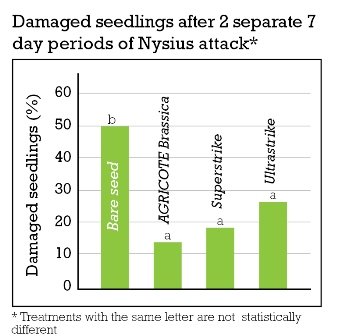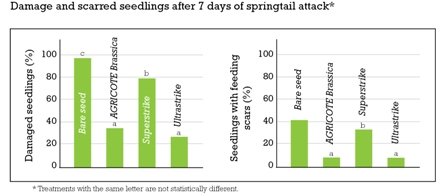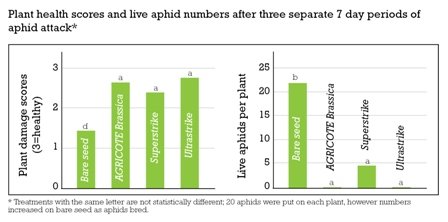Agricote brassica
Establishment is a critical time for brassica crops because plant density determines potential yield, and it is also the time plants are most vulnerable.
AGRICOTE Brassica assists establishment by providing protection against insects and fungal diseases, and by supplying molybdenum.
Nysius control
AGRICOTE Brassica provides excellent control of Nysius. Data supporting this comes from a trial run by AgResearch. Dynamo summer turnip seed was sown and Nysius was added when seedlings were just emerging, then again 7 days later.
All three seed treatments tested gave very good control of Nysius damage compared to sowing bare seed (see graph). Under the high insect pressure in the trial, AGRICOTE Brassica greatly reduced the number of damaged plants from 50% (bare seed) down to only 11%.

Springtail control
AGRICOTE Brassica provides excellent control of springtails. In an AgResearch trial Dynamo
summer turnip seed was sown into pots and when seedlings were just emerging springtails were added (which is when most springtail damage occurs).

The results show AGRICOTE Brassica and Ultrastrike seed treatments gave the best springtail control. AGRICOTE Brassica greatly reduced the number of plants damaged from 98% (bare seed) down to 34%, and reduced the feeding scars from 41% (bare seed) down to 7%. Feeding scars are the physical tissue damage that can later result in stem break in kales or rapes.
Aphid control
AGRICOTE Brassica gives excellent protection against aphids. In a trial run by AgResearch Dynamo summer turnip seed was sown into pots. Twenty aphids were added to each pot on three separate occasions: 8 days after emergence, 15 and 22 days after emergence. At the end of the trial plants were visually scored for damage on a 1-3 scale.

The results from the three aphid feeding periods combined shows plants had only a low level of plant damage when AGRICOTE Brassica was used. AGRICOTE Brassica also killed all aphids.
Fungal pathogens
AGRICOTE Brassica contains fungicide to give protection against ‘damping off’ through the establishment period, a disease caused by a combination of soil-borne Fusarium and/or Pythium fungi in the North Island, and Rhizoctonia in the South Island. Damping off can lead to poor, patchy brassica establishment.
The fungi are present in most NZ soils, and build up in successive crops, so they are worst in second year or subsequent crops.
Newly sown brassicas seedlings are most susceptible to damping off due to their small, vulnerable size. Typically they wilt and die showing small lesions at or below soil level. Plants may initially survive Rhizoctonia, but later may turn purple and die due to ‘wire stem’ caused by the damage.
Molybdenum
AGRICOTE Brassica contains the trace element molybdenum required for brassica growth and development.
Sowing rate
AGRICOTE Brassica treatment results in a 5% weight increase. Normal sowing rates apply
as a 5% reduction in the amount of seed sown is offset by the increased success in establishment.
Withholding period
A 42 day withholding period for AGRICOTE Brassica applies. Stock should not be grazed on crops within this period.

